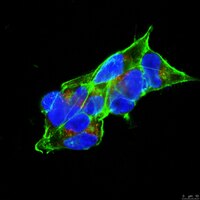MABN2297 Sigma-AldrichAnti-APP Antibody, clone 7H6
Anti-APP, clone 7H6, Cat. No. MABN2297, is a highly specific rat monoclonal antibody, that targets Amyloid beta A4 protein and has been tested for use in ELISA, Flow Cytometry, Immunocytochemistry, Immunoprecipitation, and Western Blotting.
More>> Anti-APP, clone 7H6, Cat. No. MABN2297, is a highly specific rat monoclonal antibody, that targets Amyloid beta A4 protein and has been tested for use in ELISA, Flow Cytometry, Immunocytochemistry, Immunoprecipitation, and Western Blotting. Less<<Recommended Products
Overview
| Replacement Information |
|---|
Key Specifications Table
| Species Reactivity | Key Applications | Host | Format | Antibody Type |
|---|---|---|---|---|
| H | ELISA, ICC, IP, WB, FC | R | Purified | Monoclonal Antibody |
| References |
|---|
| Product Information | |
|---|---|
| Format | Purified |
| Presentation | Purified rat monoclonal antibody IgG1 in buffer containing 0.1 M Tris-Glycine (pH 7.4), 150 mM NaCl with 0.05% sodium azide. |
| Quality Level | MQ100 |
| Physicochemical Information |
|---|
| Dimensions |
|---|
| Materials Information |
|---|
| Toxicological Information |
|---|
| Safety Information according to GHS |
|---|
| Safety Information |
|---|
| Storage and Shipping Information | |
|---|---|
| Storage Conditions | Stable for 1 year at 2-8°C from date of receipt. |
| Packaging Information | |
|---|---|
| Material Size | 100 μg |
| Transport Information |
|---|
| Supplemental Information |
|---|
| Specifications |
|---|
| Global Trade Item Number | |
|---|---|
| Catalog Number | GTIN |
| MABN2297 | 04054839415289 |
Documentation
Anti-APP Antibody, clone 7H6 Certificates of Analysis
| Title | Lot Number |
|---|---|
| Anti-APP, clone 7H6 - 3984022 | 3984022 |
| Anti-APP, clone 7H6 - 4059362 | 4059362 |
| Anti-APP, clone 7H6 Monoclonal Antibody | Q2973327 |










